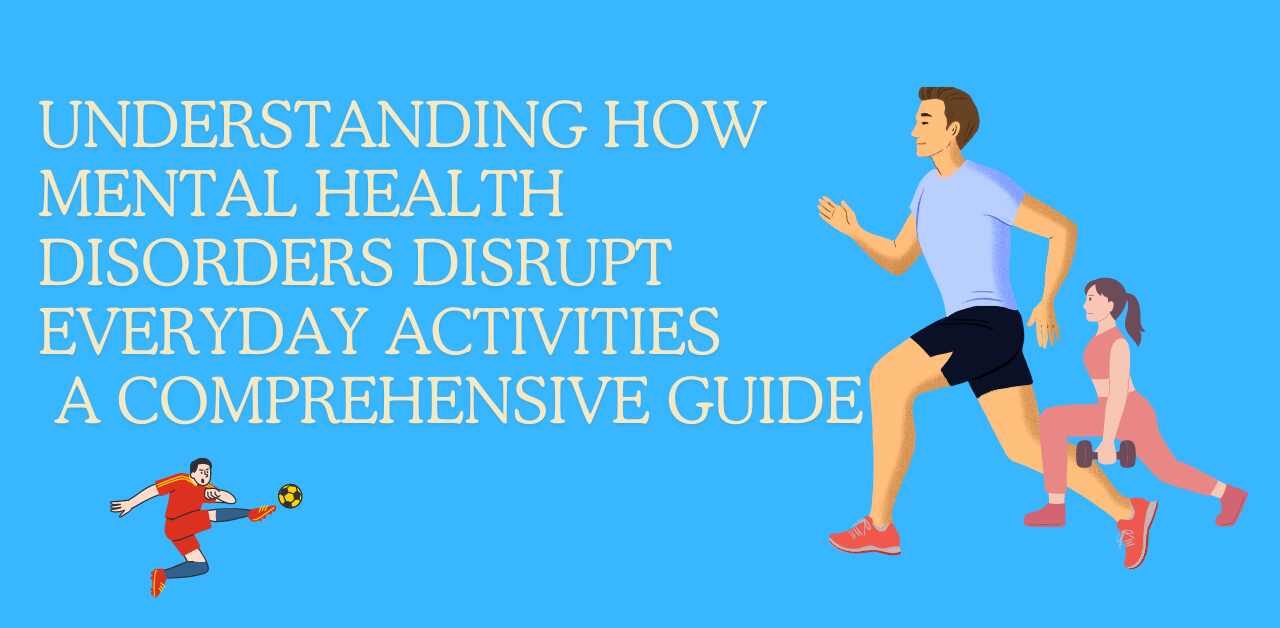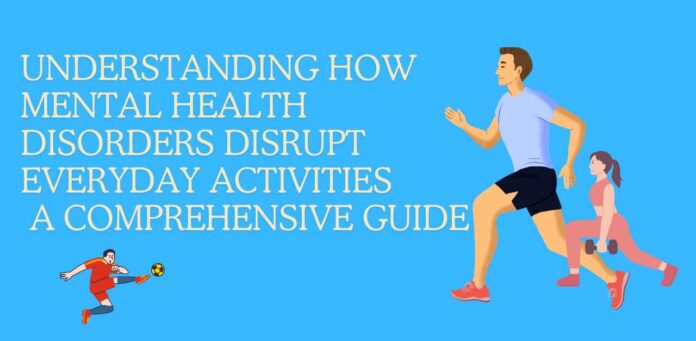Understanding How Mental Health Disorders Disrupt Everyday Activities: A Comprehensive Guide
The frequency of mental health illnesses has increased in today’s fast-paced environment, impacting a larger number of people than ever before. This article discusses various mental health issues that affect people of every stage of life and socioeconomic status and affect their daily functioning. By understanding these conditions, we can all work together to create a society that is more helpful and friendly.

Mental disorder impact:
Mental disorders impact a significant portion of the population. But which disorders are the most prevalent. which condition have a broader influence on peoples lives.
Below is a concise overview of the most widespread mental disorders and thier implications for our daily exisstance.
Disorders of anxiety:
Among the most prevalent mental health conditions, anxiety disorders impact millions of people globally. Anxious people can be too fearful, restless, and worried, which makes it difficult for them to perform everyday tasks.
Example: Sarah has difficulties focusing on her work. Because she has generalized anxiety disorder (GAD). Which is characterized by recurrently worrying thoughts about the future.
Example of anxiety disorder here are common symptoms associated with anxiety.
Cognitive Symptoms:
-
Excessive worry or fear.
-
Racing thoughts.
-
Difficulty concentrating.
-
Catastrophic thinking (expecting the worst).
-
Anticipating danger or doom.
-
Intrusive thoughts.
Emotional Symptoms:
-
Restlessness or feeling on edge.
-
Irritability.
-
Impatience.
-
Nervousness.
-
A sense of impending panic or doom.
-
Easily startled.
Phobia:
Powerful irrational anxieties about specific events or situations are referred to as phobias. Because these anxieties can be so crippling in nature, people may take extreme precautions to avoid triggers that can interfere with their daily activities.
Example: Mark’s social engagements are limited because of his extreme fear of heights. Which keeps him from going to events held on rooftops.
A Panic Episode:
An individual’s regular life may be disrupted by panic episodes. Which are characterized by abrupt and intense attacks of fear. These episodes may appear suddenly or be brought on by specific situations.
For Example: Emily’s panic episodes make it difficult for her to visit crowded areas, which hinders her enjoyment of social gatherings.
Disorders of Obsessive-Compulsive Behavior:
OCD is characterized by uncontrollably recurrent unwanted thoughts and compulsive activities. Our daily duties and routines may be disrupted by these compulsions.
Example: John’s daily routine is disrupted by spending hours every day double-checking if he turned off equipment.
Nervous Anorexia:
Anorexia nervosa is one of the eating disorders that can seriously impact a person’s life and have a negative or harmful impact on both their physical and mental health.
For Example: Mia isolates herself from social situations centered around food because of her anxious anorexia.
PTSD, or Post-Traumatic Stress Disorder:
Traumatized people may acquire PTSD, which interferes with their everyday activities as they struggle with nightmares, flashbacks, and mental pain.
For example: James, a combat veteran, finds it difficult to maintain steady relationships and a job because of his PTSD symptoms.
Mental Health Issues:
Mental health concerns are a broad category that includes a variety of conditions. They are likely to influence each aspect of an individual’s life, from mood disorders to psychotic disorders.
Example: Maria struggles to maintain consistent attendance at work due to her dual diagnosis of depression and anxiety.
Depression:
A common mental condition that affects emotion, though, and daily functioning is depression. It usually leaves victims feeling hopeless and listless.
Example: Tom struggles to find motivation for daily activities due to his depression, which affects how well he performs at work.
Disorder of Generalized Anxiety:
Overconfidence and tension about regular events are symptoms of generalized anxiety disorder (GAD). Which can cause both physical and mental pain.
Example: Rachel struggles to concentrate on her studies due to her generalized anxiety. which has an impact on her academic performance.
Conclusion of Mental Health Disorders Disrupt Everyday Activities.
Considering the impact of mental health problems on everyday activities is harmful for creating empathy and support. By treating such diseases and encouraging can did dialogue. We can try to develop a culture that places a high value on mental health and well-being. It’s important to encourage individuals struggling with these challenges to seek professional help. And create an environment that fosters understanding and exclusivity.





[…] providers, who can attest to the parent’s behavior, symptoms, and the impact of their mental illness on parenting […]
[…] This article aims to provide insights into identifying potential indicators of mental illness in […]